Conducting a fox drive
by Lignum Ralph
Hunter 3
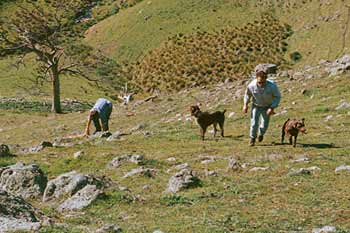 I could hear the phone ringing, but I didn’t move. What’s the use? With
three females in the house, I would have to be awful quick to beat one
of them to it. It only rang twice before it was answered and, to my
surprise, an annoyed voice announced it was for me. At this time of the
year I often receive requests from farmers in the district asking me to help take care of troublesome foxes. This was one such call.
I could hear the phone ringing, but I didn’t move. What’s the use? With
three females in the house, I would have to be awful quick to beat one
of them to it. It only rang twice before it was answered and, to my
surprise, an annoyed voice announced it was for me. At this time of the
year I often receive requests from farmers in the district asking me to help take care of troublesome foxes. This was one such call.
This year’s lambs were fetching record prices and every dead lamb lying out in the paddock was equivalent to at least one $50 note blowing around in the breeze. Apparently, foxes were getting stuck into Peter’s lambs and he wanted to know if and when I could help him out.
Peter’s property borders a swamp of about 1000 acres and at present it was bone-dry with extremely thick ground cover. Added to this was the fact that it was past what was generally considered to be the good calling period, so a drive would have to be the order of the day.
The particular swamp in question was no different to dozens of other swamps scattered around the state that have become havens for foxes and no matter how many foxes are taken, there rarely seems to be a shortage of them in such places.
I hunt around this swamp on private property quite a lot during the warmer months and have taken dozens of foxes but still they keep coming. Goodness only knows what would happen if hunters stopped shooting them.
The European fox is a true survivor and is turning into an environmental nightmare. Who knows how many of our smaller marsupials and birds are being pushed into extinction by their predations. A good deal of the blame lands squarely on the shoulders of the animal rights movement who helped curb the highly successful fox fur industry. Their ignorance, or lack of understanding, is going to be the downfall of many of our magnificent creatures.
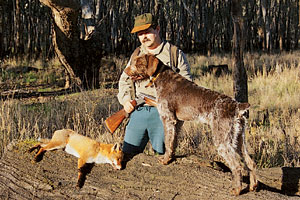
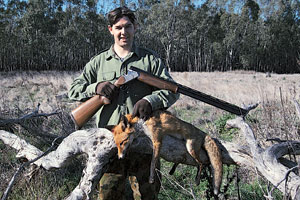
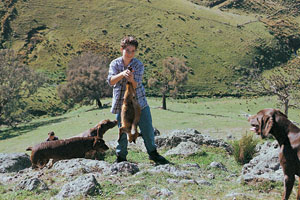
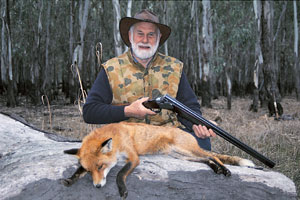 On Peter’s property the foxes were being seen wandering around during daylight hours and were becoming quite cheeky. I assured Peter that I
would be able to help out and further stated that I would organise a
drive for the following weekend. During the week I rang the local DNRE
office and told them of our plans; the local officer arranged
permission for us to hunt this particular swamp. As they had stopped
baiting the area, he was glad to hear that we were conducting a drive.
On Peter’s property the foxes were being seen wandering around during daylight hours and were becoming quite cheeky. I assured Peter that I
would be able to help out and further stated that I would organise a
drive for the following weekend. During the week I rang the local DNRE
office and told them of our plans; the local officer arranged
permission for us to hunt this particular swamp. As they had stopped
baiting the area, he was glad to hear that we were conducting a drive.
The following Saturday morning we all gathered by the big dam at the north end of the swamp. Some had even camped overnight, such was their enthusiasm. There was only about a dozen of us, not nearly enough, but such is life. Some had brought their children along to act as beaters and they were quite excited about it all.
After the conditions of the hunt and safety rules were laid out, the majority of the hunting party headed around to part of the swamp, about three-quarters of a kilometre from the beaters. We gave the shooters about 20 minutes to get into position and started off towards them with six eager German short-haired pointers (GSP) working the thick scrub in front of us.
An excited yelping had me looking at my dog, Cobber; I knew he was onto something. Sure enough a big buck hare broke cover and headed straight past me. A member of our party had previously stated he wanted a couple of hares to take home to eat so I quickly brought the hare down with a load of No 2 shot from my Beretta 686E under and over. Cobber turned up a short time after the shot and, seeing that I had got the hare he had been chasing, he immediately headed off to rejoin the other dogs.
A couple of shots rang out from down the shooter’s line signalling that a fox had got up early, as is often the case, and run into trouble. The ground cover in the swamp was proving quite difficult to hunt and no doubt the odd fox that had been through it all before was using the thick cover to its advantage and slipping out the side. We simply didn’t have enough members to cover all retreats.
When we finally struck the out markers of the shooter’s line, all guns were broken and a quick pow-wow was held. Two foxes had been sighted, with one slipping back behind the drivers, while the other fell to a well-placed load of BBs. On the next section of the drive a number of foxes were flushed with a couple of them going down, which was good as they were taken in the section of the swamp adjacent to my friend’s property. While not being a raging success, a few foxes were taken on the drive, which no doubt eased the burden a bit - but not enough. We would be conducting another drive in the near future.
This form of fox hunting is extremely popular, as can be attested to by the vast number of hunters heading out frequently. By joining an association, such as the SSAA, a hunter has the dual opportunity of meeting fellow kindred spirits and, for those city-based hunters, the chance to hunt on private properties that would otherwise be closed to them. The old time-honoured fox drive is a great way to spend a sunny winter’s day with mates. You can either become a SSAA member and go on one of their organised drives or you can conduct one of your own.
Organised fox drives serve many purposes. To start with, they help take the pressure off our native wildlife and, of course, help our farming communities. Because of these reasons, this form of fox hunting gains a lot of favourable media coverage, especially on country networks, and this can only help the cause of our much-beleaguered recreational activity.
Fox drives can be as simple as you like or they can take on the appearance of military manoeuvres; it all depends on how big an area you wish to hunt or how many hunters wish to participate.
The places I like to tackle are those bracken-lined steep gullies that have plenty of blackberry and sweet briar clumps for foxes to hide in. If these gullies run uphill it is a simple matter of placing hunters at the top in strategic places covering as many escape routes as possible, then run the dogs through the thickest bits of cover.
Foxes are not particularly worried about hunters, but dogs are an entirely different proposition. Once they know that dogs are on their trail they move out very quickly. Quite often, soon after the drivers enter the gully and turn the dogs loose, foxes will immediately emerge from the top of the gully. This surprises the waiting hunters who were not expecting action quite so soon. Foxes are smart enough to know that when dogs are involved in the hunt, it’s time for them to move on and fast.
Another extremely popular place is rice stubbles; foxes just love living in these. Obviously, quite a number of hunters are required to bottle up these stubbles. The choicest spots for a hunter to stand by are the irrigation ditches that surround the rice crop and are used for irrigating. Once dry, these ditches are the perfect spot for a fox to use in its bid to escape. By standing close to one of these ditches, a hunter is virtually guaranteed of some fast and furious action. It takes an experienced hunter to calmly fire, reload and fire again, especially when every fox in the stubble has chosen the ditch he is covering as a bid to escape. It was far simpler when we were able to use our self-loaders, but now that we only have our side-by-sides or under and overs, the pressure is really on.
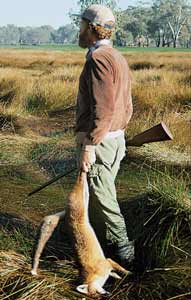 When a drive commences, the foxes taken early are usually quite easy,
with the fox simply trotting straight up the barrel, more often than
not stopping to casually glance back over its shoulder to see how close
the pursuant is. Don’t ever sell the old fox short, as it is an
extremely cool customer, even under extreme pressure. However, as the
drive progresses the foxes remaining between the drivers and the
waiting hunters realise that something is up and try to evade the
waiting guns by doubling back, trying to escape behind the drivers.
Those that keep moving forward are very alert and break cover, moving
very fast and low to the ground.
When a drive commences, the foxes taken early are usually quite easy,
with the fox simply trotting straight up the barrel, more often than
not stopping to casually glance back over its shoulder to see how close
the pursuant is. Don’t ever sell the old fox short, as it is an
extremely cool customer, even under extreme pressure. However, as the
drive progresses the foxes remaining between the drivers and the
waiting hunters realise that something is up and try to evade the
waiting guns by doubling back, trying to escape behind the drivers.
Those that keep moving forward are very alert and break cover, moving
very fast and low to the ground.
The only safe firearm to use on a fox drive is a shotgun. Heavy loads of No 2 shot or BB shot are popular for taking foxes on drives and give a good account of themselves. Personally, I prefer to use AAAs for my fox hunting, which usually occurs during the cooler months for numerous reasons. At this time of the year the fox’s fur is at its thickest and that little bit of extra punch the AAAs give is often appreciated.
Ask six different fox hunters what type of dog they prefer for fox hunting and you will probably get six different answers. I prefer GSPs, as they have the stamina to put in a hard day’s hunt and their scenting ability is second to none.
Other teams that I know of have a mixture of dogs. They use Jack Russells to flush the foxes from the thickest of covers. These tenacious little dogs are capable of squeezing through the smallest of crevices in their search for foxes and really do give a good account of themselves. Others like the speedsters, along the lines of the staghound, and these dogs really are poetry in motion when flat out after a fox across open countryside. No matter what dog you choose to use, rest assured they only add to the success of the hunt.
If you have never been on a fox drive you are doing yourself an injustice. If you cannot round up enough members to run your own, join the SSAA and participate in one of their organised drives. I guarantee you will be pleasantly surprised.
